Archived Storm Damage Blog Posts
3 things to do to get your home ready for winter storm weather
3/3/2025 (Permalink)
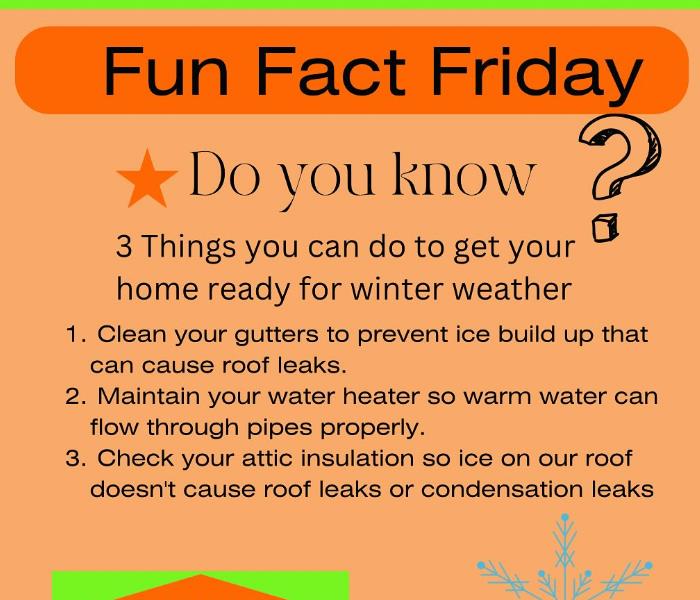 Chart featuring the three tips to keep your home ready for winter storm weather
Chart featuring the three tips to keep your home ready for winter storm weather
Do you know what three things you can do to get your home ready for winter weather? The first tip is to clean your gutters so that ice doesn't build up. If ice builds up, it can cause roof damage that can create a leak inside. The second is to keep your hot water heater maintained so hot water can run through your pipes easily. Finally, check our attic insulation. If your attic isn't insulated properly, it can create leaks from condensation. If you do find you need help this winter, be sure to give us a call!
Be Prepared for Impending Hurricane's During This Time of Year
9/10/2024 (Permalink)
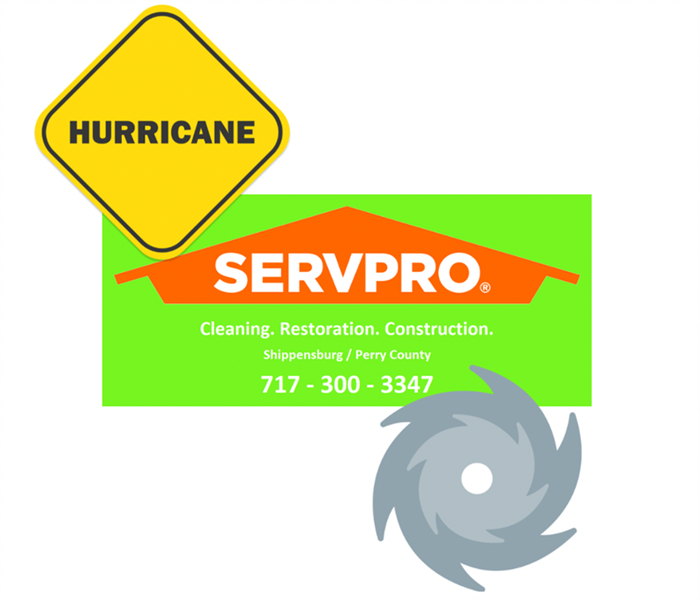 SERVPRO symbol, hurricane symbol and a precaution sign.
SERVPRO symbol, hurricane symbol and a precaution sign.
Do you know any safety precaution's for hurricanes? The more prepared you are the less damage to your home will occur. We are always here to help whether damage occurs from a storm or not. Check out the tips below.
1. Secure any yard items that could blow
2. Board up windows
3. If your basement frequently floods, take precaution by moving items off the floor and/or servicing your sump pump.
4. Consider the use of sandbags around the outside of your home.
If damage does occur don't forget to call us!
What Should You Do When the Snow Melts and the Rain Comes Down Hard
9/10/2024 (Permalink)
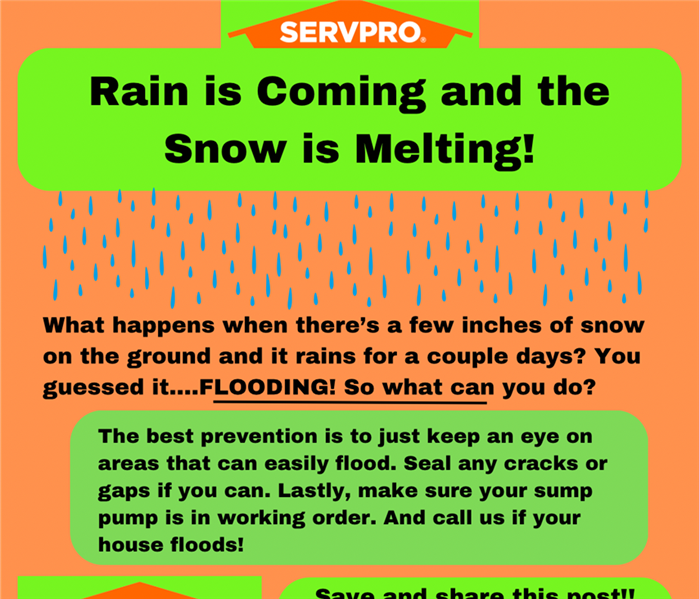 A graphic explaining what do do when flooding rain comes and there's already snow in the ground.
A graphic explaining what do do when flooding rain comes and there's already snow in the ground.
What happens when there's snow on the ground and spring rains come? That's right, flooding. So what can we do to help prevent flood damage in to our homes? Be sure to keep an eye on areas that flood most easily. Do you live in a flood plane? Do you live near a body of water that floods? If so, take proper precautions such as making sure your sump pump is in working order. Also fill and seal any cracks and or gaps in your foundation. And if damage does unfortunately occur, be sure to call us for help! We can extract water, do proper dry out, clean up the mess, and rebuild!
How to Prepare for an Impending Storm
6/12/2024 (Permalink)
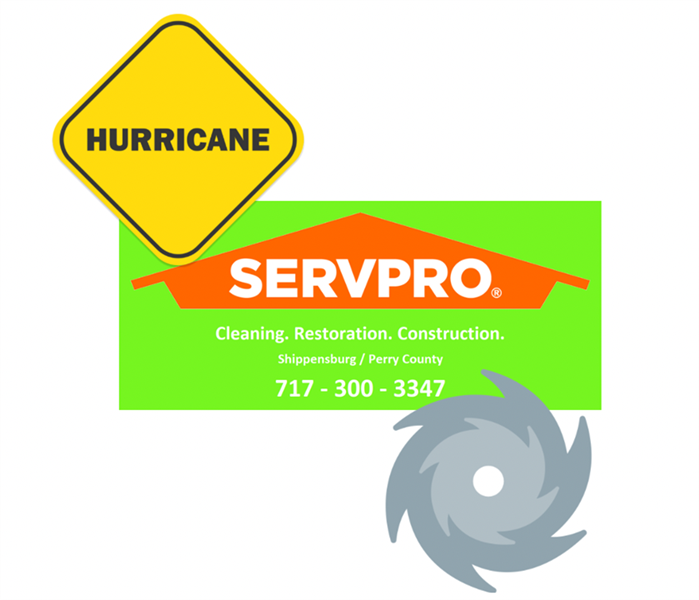 Be sure to call us if you have hurricane damage this hurricane season.
SERVPRO of Shippensburg/Perry County (717)-300-3347
Be sure to call us if you have hurricane damage this hurricane season.
SERVPRO of Shippensburg/Perry County (717)-300-3347
Hurricane season is right around the corner. What can we do to prevent major damage?
One result of hurricanes or other storms is flooding. The best prevention for flooding is to just keep an eye on areas that can easily flood. Seal any cracks or gaps if you can. Lastly, make sure your sump pump is in working order. And call us if your house floods!
Another helpful tip is to put together an emergency kit to include flashlights, generators, and non-perishable food.
It is also important to make an emergency family plan. Decide how to evacuate, where to meet, and what do to in case you get split up.
Lastly, a few other important tips are to review and understand your insurance plan, board up doors and windows, secure outdoor items like grills, AND don't forget to locate the number for your nearest
| SERVPRO®
franchise in case you do incur damage and need to call us!
Tip Tuesday: Preventing Secondary Damage from Water or Storms
5/14/2024 (Permalink)
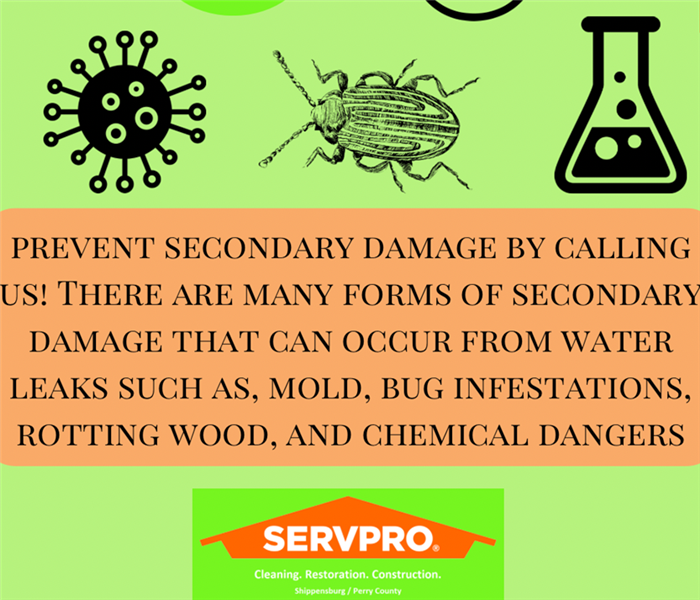 See the graphic for information on what can occur from secondary water damage in your home
See the graphic for information on what can occur from secondary water damage in your home
Often times secondary damage can occur from water damage in your home that can be caused by storms and heavy rain. Secondary damage can include, rotted wood, bug infestation, mold, and chemical dangers. Be sure to call us if you're concerned about secondary water damaged caused by a storm.
| SERVPRO® of Shippensburg/Perry County (717)-300-3347
Five Steps to Avoid Mold Growth After a Flood
9/14/2023 (Permalink)
 | SERVPRO® of Shippensburg/Perry County (717)-300-3347
| SERVPRO® of Shippensburg/Perry County (717)-300-3347
Flooding is the leading natural disaster in the U.S and flooding can wreak havoc on a home or building that lasts long after waters recede. Over the past five years, the average paid flood insurance claim was more than $35,000, according to the National Flood Insurance Program (NFIP). From damaged personal items to the growth of mold spores that can impact the health of a home and its inhabitants, taking the proper steps to restore a property after a flood can limit the extent of the damage incurred.
To help direct home owners and businesses during cleanup efforts, the Institute of Inspection Cleaning Restoration and Certification (IICRC) and the Healthy House Institute (HHI) share the following five steps for preventing mold growth after a catastrophic flood.
Step One: Check it out!
- Once a building is flooded from a river, lake, stream, hurricane or rainstorm, inspecting and documenting damage is very important for several reasons, including insurance and tax purposes. Electrical, gas, structural and other safety hazards present must be eliminated "before" assessing physical damage to the building and contents.
- Once health and safety hazards have been eliminated, inspect the building and all contents. Generally, the rule of thumb is that everything below the water line gets thrown out. Building materials and contents above the water line should be inspected for discoloration, odor and damage.
Step Two: Get it out!
- Extract standing water with a pump or wet vacuum from slabs, basements, crawlspaces, heating systems and anywhere water could be sitting. Shovel or flush out remaining silt and sand with water.
- Next, remove all wallboard material (e.g., plaster, drywall, paneling), finished flooring (e.g., carpet, hardwood, vinyl flooring), insulation and any other wet materials that are below the water line.
- Remove contents damaged by floodwater. Keep a record of your activities before, during and after cleanup. Take photo or video recording inventory of discarded material.
Step Three: Clean it up!
- Start with vacuuming as much loose debris and soil as possible. It is preferable to use a HEPA vacuum, but a simple wet/dry vacuum can work. When using a wet/dry vacuum, attach a hose to the exhaust and vent the exhaust air to the outside. This keeps dust, spores and other fine particles from being suspended in the air and settling back on clean surfaces.
- Clean framing with a pressure washer or low-pressure flushing. Scrub framing with a mild detergent (e.g. dish soap) to remove embedded soils. Wipe all adjacent surfaces with a mild detergent. Rinse by low-pressure flushing or wiping with clean water. Vacuum all remaining moisture using a wet/dry vacuum.
- If mold is visible and remains after cleaning, additional scrubbing or multiple rounds of cleaning may be necessary. If significant mold growth is present, or if occupants have immune deficiencies, are elderly, pregnant, or if there are young children present.
- After all surfaces are clean, wipe surfaces with a sanitizer such as a solution of up to ¼ cup of bleach to one gallon of water. After 20 minutes, wipe surfaces using clean water. This step helps neutralize remaining or embedded contaminants.
- For those with chemical sensitivities, perform multiple rounds of cleaning as an alternative to using bleach.
Step Four: Dry it out – quickly!
- Mold spores are everywhere, and it is impossible to remove all spores and potential contaminants. All spores need to grow is moisture. To inhibit future mold growth, dry affected areas as quickly as possible, preferably within 24 to 48 hours from the completion of cleaning and sanitizing.
- The key is directing warm, dry air across wet surfaces. This directed airflow should be exhausted outside or collected using dehumidification equipment. Take care to not spread contaminants. Properly directing airflow may require putting up barriers or containing the affected areas to prevent the spread of contaminants to unaffected areas.
- Drying a wet building correctly is an art as well as a science. IICRC trained and certified experts know how to use state-of-the-art moisture detection and monitoring equipment that identifies hidden moisture in building materials, ventilation systems, flooring and walls. Certified restorers also understand and use the equipment necessary to dry buildings, while preventing the spread of contaminants.
- In a community-wide flood, the availability of power and rental equipment to complete structural drying can be a challenge. If drying cannot be properly initiated, contact an IICRC Certified Firm.
Step Five: Keep it dry
- The cardinal rule for preventing mold growth is to keep surfaces dry. Strive to ensure your home stays dry and you will be following industry best practices for preventing mold growth and protecting the health of others in your home. It’s also a way to protect the investment of your home, since excess mold growth and moisture will damage the structure. Try to keep indoor humidity below 50 percent using air conditioning or a dehumidifier.
- Tip: Use a water-sensing alarm (battery-operated) in moisture-prone areas such as next to the washer, hot water heater, in the basement and other possible wet zones, so you are alerted to the accumulation of excess moisture.
No one wants to experience the devastation of a flood, but by keeping mold outside where it belongs, you can limit its impact on the health of your family and home.
At SERVPRO of Shippensburg/Perry County we are ready and able to address any and all water damage issues that you may have in your home or business. We have the resipources and the capabilities to remediate any size loss. Give us a call at 717-300-3347
Note: the source of the above information is http://www.healthyhouseinstitute.com/a-1328-Five-Steps-to-Prevent-Mold-Growth-after-a-Catastrophic-Flood
What to do AFTER the Hurricane | SERVPRO® of Shippensburg/Perry County (717)-300-3347
9/14/2023 (Permalink)
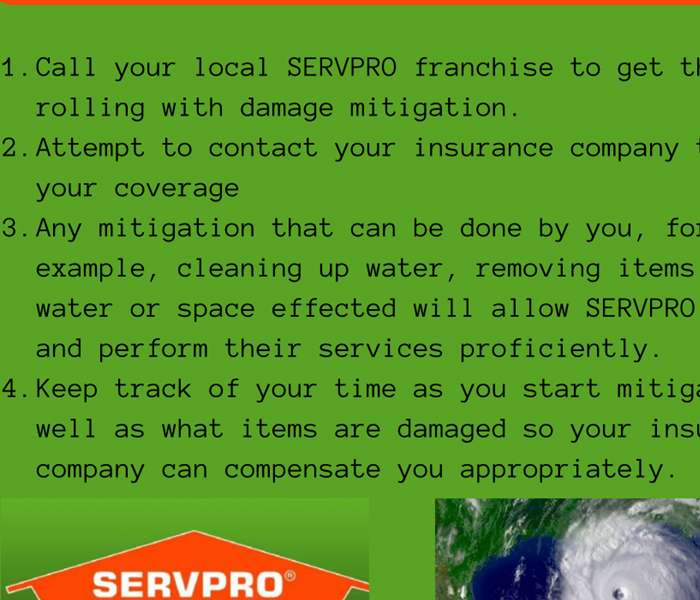 | SERVPRO® of Shippensburg/Perry County (717)-300-3347
| SERVPRO® of Shippensburg/Perry County (717)-300-3347
See graphic below for what to do after the devastation of a hurricane hits your home.
Be Prepared For Flood Damage! | SERVPRO® Shippensburg/Perry County 717-300-3347
6/8/2023 (Permalink)
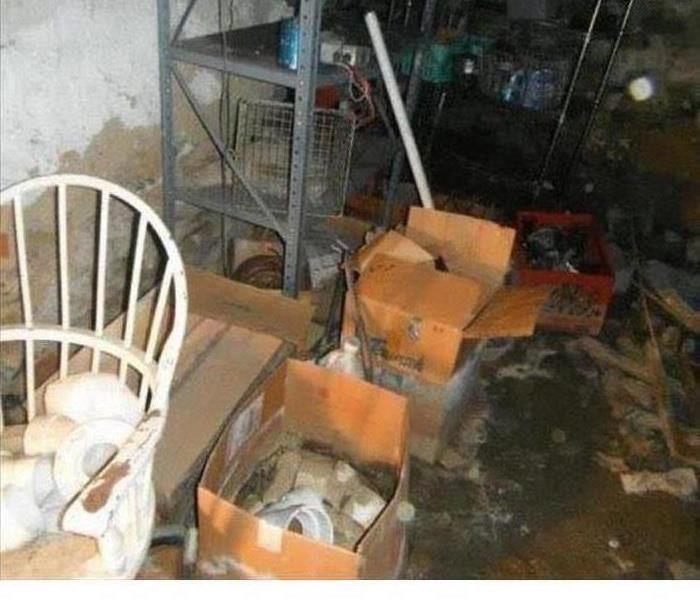 | SERVPRO® of Shippensburg Perry County 717-300-3347
| SERVPRO® of Shippensburg Perry County 717-300-3347
Many people deal with the ravages of flood damage in our region.
Our partners at the Red Cross have prepared a very helpful list of action items to follow before and after you are impacted by flood damage.
When flood damage threatens to take-over your life - we at SERVPRO of Shippensburg/Perry County are here to help you take back control. Our hero's are ready to help 24/7.
NO Job is Too Big or Too Small for SERVPRO!
5/31/2023 (Permalink)
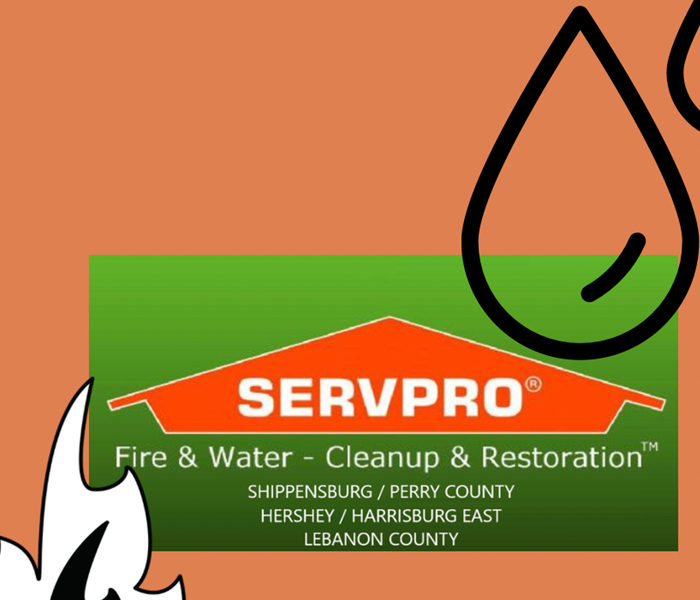 SERVPRO logo with water drop and fire
SERVPRO logo with water drop and fire
SERVPRO Storm Damage Cleanup & Restoration
Disaster Recovery Team
When a natural disaster strikes it can be all too easy to lose hope in light of severe damage and loss. Whether it’s a tornado, hurricane, blizzard or flood – the SERVPRO Disaster Recovery Team can provide help fast.
No Disaster Is Too Big
The SERVPRO System has a network of strategically positioned storm teams on standby should a disaster strike near you. Available 24 hours a day and 365 days a year, SERVPRO of Hershey/Swatara Professionals are prepared for the unpredictable.
With the ability to mobilize local command centers, along with the resources of more than 1,600 Franchises nationwide, no disaster is too big.
Recent mobilizations of the Castastrophic Storm Response Teams include:
- 2012 Sandy
- 2010 Nashville Floods
- 2008 Ike
- 2007 Chicago floods
- 2007 Ohio floods
- 2007 California wildfires
- 2005 Katrina/Wilma/Rita
Should a catastrophic storm strike, call (717) 300-3347. SERVPRO SHIPPENSBURG services Shippensburg Pa and surrounding areas.
Even in the face of a disaster, SERVPRO of Hershey/Swatara Professionals will strive to help make it "Like it never even happened."
Be Prepared for the Destruction Caused by Lightning | SERVPRO® of Shippensburg/Perry County
9/20/2022 (Permalink)
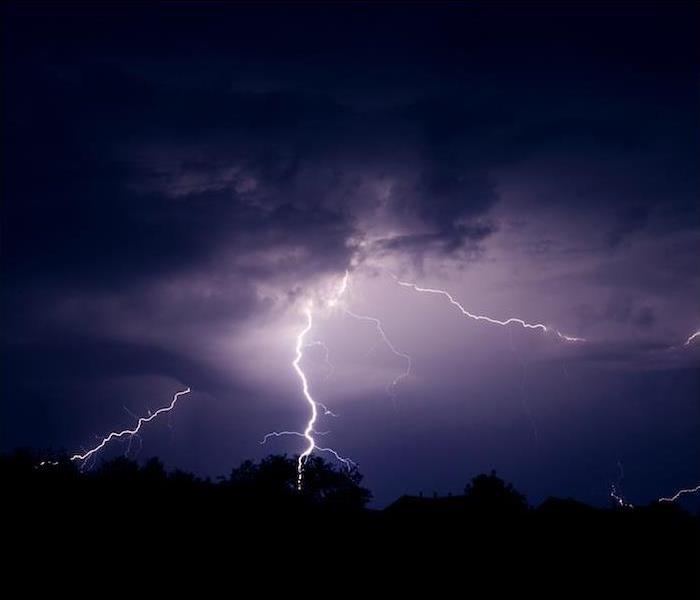 If you are dealing with a fire damage from a recent fire, call SERVPRO of Shippensburg/Perry County about a restoration solution for your issue.
If you are dealing with a fire damage from a recent fire, call SERVPRO of Shippensburg/Perry County about a restoration solution for your issue.
Homeowners work hard to protect their properties from flames by practicing fire safety and utilizing firefighting tools. While many interior fires are manmade and largely preventable, other house fires can start as a result of natural threats and can impact your home out of nowhere.
More than 70,000 damage claims resulting from lightning strikes were made in 2020. While it is actually very uncommon for a person to be struck by lightning, your property is considerably more prone to being hit. And when lightning does strike, it has the power to wipe out your electricity, destroy trees and even ignite a fire.
Approximately 6,000 lightning strikes are thought to occur per minute. This shows that nobody is truly immune to this danger and that every one of us needs to be ready to safeguard our homes and ourselves before a storm takes place.
What Is Lightning?Lightning is a massive flash of electricity that occurs among clouds in the air and on the ground. Thunderstorms aren’t the only cause of lightning, though. It can also strike during volcanic eruptions, strong wildfires and even intense snowstorms.
We relate lightning to dangerous weather, but it can also strike when the sky is completely clear. “Dry lighting” is produced without rain and poses a very significant danger because wildfires are created as a result. So, while we start to get ready for storms, we also need to think about fire safety.
Protecting Your Home From Lightning FiresWhen lightning strikes your home, fire may soon follow. Fires are a result of either the temperature of the strike or the electricity created by the strike.
It might not be immediately apparent when a fire begins as a result of the strike, as a lightning-related fire will typically erupt up in your attic or between your walls.
Listen for a distinctive, loud boom when the strike occurs. If you discover your home has been struck, look for indications of burning and call the fire department as soon as you detect black markings or smell smoke.
One of the most effective strategies to avert lightning-related fire is to install a lightning rod. This metal pole can direct the power of a lightning strike away from your house so that it is not directly affected by the heat and electrical current of the hit.
When Lightning Strikes NearbyLighting is a common culprit of wildfires and other outdoor flames. There are several “peak” seasons for lightning fires in various regions of the country, but on average, 9,000 fires are ignited by lightning strikes annually.
Clear your yard of any debris or decaying vegetation, and utilize a defensible zone to keep your property safe from the hazards of a lightning strike. Make sure to install a smoke alarm on every floor of your home so that if a fire breaks out, you will instantly be notified.
When your home is damaged by flames, contact our team of professionals at SERVPRO. Fire restoration can be a difficult process, but our team makes it quick and painless through years of expertise and the use of state-of-the-art technologies. We will get your home back to its pre-fire state as soon as we can.
Have you experienced smoke or fire damage in your home? Call us today to get the restoration finished fast.
Addressing the Flooding Risk for Your Property | SERVPRO® of Shippensburg/Perry County
9/12/2022 (Permalink)
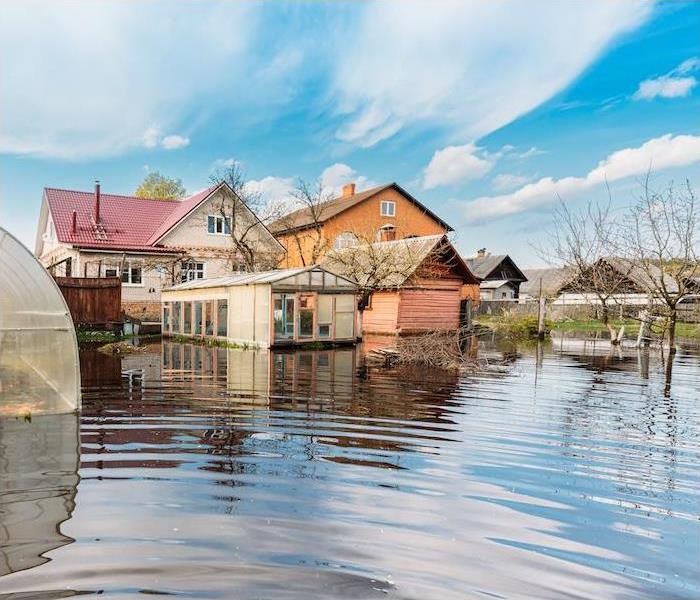 Experienced water damage in your home? Call SERVPRO of Shippensburg/Perry County to get the restoration process started right away.
Experienced water damage in your home? Call SERVPRO of Shippensburg/Perry County to get the restoration process started right away.
No matter what your risk of flooding is, you should always be prepared for the unexpected. Water can cause extensive damage, even when it is a seemingly small amount.
In addition to the extensive damages, floods can be tricky to recover from as not all homeowners insurance policies cover flooding. Thinking about having to foot the bill for the entire restoration should have you taking preventive measures today!
The highest risk of flooding occurs along any of our waterways, like Brandywine Creek. We are also always at risk of springtime flooding when the snow melts, as that water can raise water levels and also soak down through the earth and into our basements.
Start With Your PropertyAll it takes is one ill-timed thunderstorm with heavy rain to leave you with a large water mess. Take some simple steps to prepare your home outside, like clearing your gutters and ensuring your downspouts are connected. These are great ways to keep water flowing away from your home.
You can also make your garden work for you! In addition to providing fresh vegetables or pretty flowers, a garden can help soak up excess water and prevent pooling in your yard. Just make sure to angle your garden plot away from your home so the water will flow down to your garden.
Also consider adding a rain barrel to your property! Rain barrels can keep the water flowing from your gutters in one localized area, which allows you to dictate exactly where it will go.
Flood Problems Inside the HomeFlood issues often originate in the basement, so taking the time to care for your foundation is a great place to start. Seal up any cracking you notice and address any dampness you discover right away.
Having a sump pump is another option to help you keep water away from your basement. If you live in a particularly high risk area, look into investing into a battery-operated pump so that you won’t ever be caught without help, even when we lose power.
Unreliable appliances and rusty or long forgotten pipes can also increase your flood risk inside your home. Address any dripping water or leaks right away, and add leak sensors below any appliances that will alert you of any problem the moment they detect water.
Lastly, take care to store the things that mean the most to you up high or out of harm’s way. Water loves to destroy photographs and other keepsakes, so have a way to keep them safe. It is also important to keep copies of any documents and your emergency plan in a waterproof location as well.
If you still find water in your home after preparing as best as you can, don’t panic! Just be sure to act quickly to prevent long-term problems and irreparable damage.
Experienced water damage in your home? Call SERVPRO of Shippensburg/Perry County today to get your restoration completed faster.
Stay Weather-Aware to Protect Yourself and Your Home | SERVPRO® of Shippensburg / Perry County
7/12/2022 (Permalink)
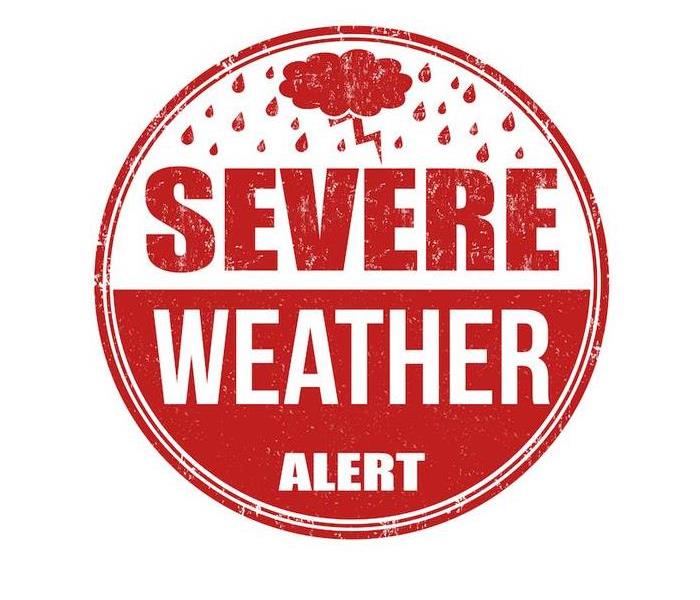 If you suspect any damage to your home from a recent storm, call SERVPRO of Shippensburg / Perry County 717-300-3347
If you suspect any damage to your home from a recent storm, call SERVPRO of Shippensburg / Perry County 717-300-3347
There are about 42 different types of weather warnings, each categorized into seven different weather-related groups. These alerts are sent out when severe weather conditions arise in your location. This information can be complicated to understand when a strong storm is forecast to strike your neighborhood.
Understanding what these weather warnings based on where you live can help you prepare for whatever circumstances may arise. These alerts are also a useful way to safeguard your home before severe weather impacts it.
While being aware of all kinds of weather scenarios is beneficial, being aware of the weather patterns that could hit our community here in Shippensburg / Perry County is even more vital.
How Alerts Are Issued
So, how are forecasters able to provide these weather warnings? Since weather forecasts are merely predictions, how can we determine the severity and location of a storm? There are many factors that impact why these alerts get sent out.
The National Weather Service works to provide accurate weather forecasts as well as weather alerts as these conditions develop. These advisories are issued by six regional offices around the country, allowing for more accurate predictions based on location. You’ll find Shippensburg and Perry’s alerts provided from the Eastern Region headquarters in Bohemia, New York, along with local offices nearby.
Meteorologists use solar activity, weather balloons, satellites and even ocean buoys to make forecasts. These predictions will vary based on the severity of the weather event, but the primary objective is to provide the most accurate forecast possible.
The Most Important Alerts to Understand
When deciphering these alerts, the words “watch” and “warning” tend to pop up often. You’ll see this language used in weather alerts, including those for thunderstorms, winter storms and flooding.
A watch means a storm is being monitored and could become dangerous, so you should make a plan to be able to withstand potentially hazardous conditions. Watches are often issued in a larger area, while a warning is issued in a smaller, more specific area like a county or city.
A warning means a severe storm is imminent and you should take precautions immediately.
It’s also crucial to know what kind of weather to expect in your area so that when you get these alerts, you’ll know what your next plan of action will be to keep safe. Here in Shippensburg / Perry County, we see a mixed bag of weather throughout the year.
Winters are snowy, icy and often very cold, while our summers are warm and humid. We may see strong winter storms, along with the potential for thunderstorms and even tornadoes in warmer times of year.
Protecting Your Home During a Storm
While monitoring weather alerts is the safest approach to defending your property and life during severe weather, there are a few other things you can do around the house to reduce the risk of damage.
Clear your gutters and fasten any outdoor furniture to protect your home from the impact of weather like floods or strong winds. Locate a secure place to wait out the storm and have an exit plan prepared in case your family needs to relocate.
SERVPRO of Shippensburg / Perry County can take care of any of your restoration needs if your home is impacted by severe weather. We can devise and carry out an effective repair plan to restore your home to its original condition.
Staying informed about weather conditions that may affect your neighborhood is an excellent approach to protect yourself and your property from tragedy. Understanding the various weather alerts will help you best prepare for any storm that may pass through our area.
Experienced storm damage to your home or property? Contact us today for a quick response!
The Cost and Frequency of Extreme Weather in 2020 | SERVPRO® of Shippensburg / Perry County
7/8/2022 (Permalink)
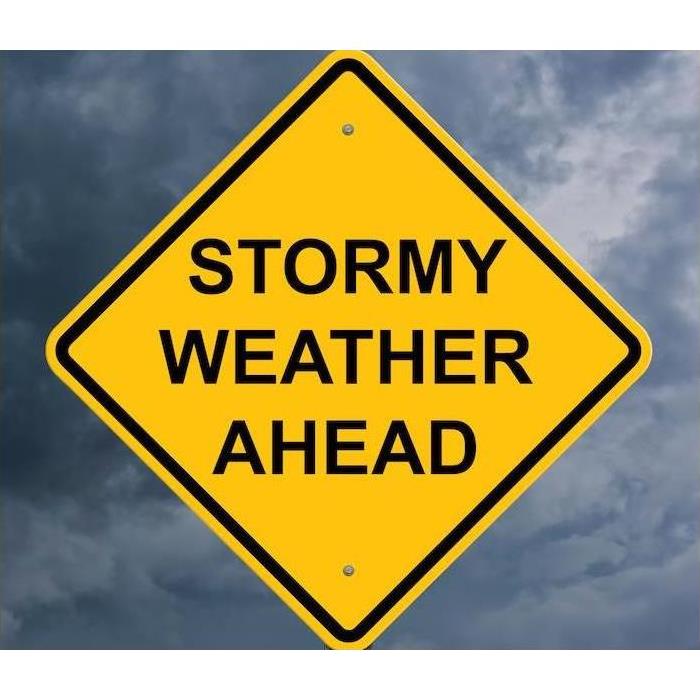 When storms do damage, we go to work to make things right. Contact SERVPRO of Shippensburg / Perry County to start the restoration process.
When storms do damage, we go to work to make things right. Contact SERVPRO of Shippensburg / Perry County to start the restoration process.
Most of us are all too aware that 2020 was a devastating year. But the degree to which 2020 was disastrous might go even further than you realize—not only did the year see a global pandemic and a nationwide quarantine, it also broke existing records for extreme weather disasters.
In fact, 2020 saw more weather disasters than any previous year on record.
The National Weather Service classifies a weather event as a disaster once it causes at least a billion dollars in damages, and 2020 brought a record 22 of these events. That doesn’t even count the numerous storms that only caused a few hundred million in destruction—there were so many storms in the Atlantic last year that the NWS had to use letters from the Greek alphabet to give them all names because it ran completely through its planned list of names for the year.
And even here in Pennsylvania, we had more weather alerts in 2020 than “tornado alley” states like Kansas.
Not Just Hurricanes
The blame often falls on hurricanes first when we think of extreme weather damage, but in truth, the most expensive disasters of 2020 in the contiguous United States were thunderstorm systems and the tornadoes some of them birthed: Fourteen of the 22 major events were storm-related.
Not Just 2020
While we certainly would hope 2020 to be an extreme example, it does seem to be following a trend of especially dangerous years for severe weather outbreaks. The previous two years joined caused a combined $136 billion in damages, and 2017 saw a record-high $300 billion.
Indeed, each of the last 10 years has suffered at least eight major weather disasters in the U.S., and the last six years have seen a minimum of 10 each.
Storms happen year-round and are no respecters of locale, so it’s crucial that we stay alert and prepared when storms are forecast. But if extreme weather overcomes your preparations, remember that SERVPRO is on call 24⁄7 to help you through the restoration and recovery process.
When storms do damage, we go to work to make things right. Contact SERVPRO today to see how we can help.
Don't Let Storms Get the Better of You | SERVPRO® of Shippensburg/Perry County
5/26/2022 (Permalink)
 If you discover storm damage to your home or business, reach out to SERVPRO of Shippensburg/Perry County right away.
If you discover storm damage to your home or business, reach out to SERVPRO of Shippensburg/Perry County right away.
You don’t want storms to catch you and your household off-guard. Their severe effects, such as lighting and heavy rain, can damage your home or even your well-being. There are around 100,000 thunderstorms throughout the United States every year, and they can affect you at any moment.
In Shippensburg/Perry County, hurricane remnants can make landfall, leading to property damage and flooding. For example, Hurricane Ida had an impact on the county in 2021. More than four to eight inches of rain were dumped across the county.
This is why it’s vital to prepare for severe weather by putting together an emergency kit and communications strategy to deal the aftermath. Preparation will make a world of difference to reduce a storm’s impact on you and your home.
Your Severe Weather Communication StrategyIf you encounter severe weather, you want to make sure everyone in your household can receive communications from authorities. You also need to know the difference between weather watches and warnings so you know when to be aware and when to seek shelter.
The next items you should have in your possession are a cell phone and an NOAA weather radio.
You should also have a communication strategy for your household. This should include your safe space that everyone knows to get to in the event of bad weather. Additionally, coordinate a communication plan in case any family members are away from home when a storm hits.
Your Severe Weather Emergency KitYour emergency kit is an essential piece of storm preparation. It needs to consist of enough essentials to support your family for at least 72 hours of sheltering in place. Essentials should include durable food, water, flashlights and first-aid supplies. Store the kit in your at-home storm shelter area.
Your Severe Weather Aftermath ChecklistOnce the storm is over, you need to take a look back at your safety plan and evaluate its effectiveness. You can do this by gathering feedback from your household on the communications, emergency kit and any other elements that could use improvement the next time a storm strikes.
The other step you need to take is checking your property for any damage. Look specifically at your roof and the seals around windows and doors where water damage is likely.
If there is damage, SERVPRO of Shippensburg/Perry County is available 24⁄7 to help you address it. We will provide you with a team of trusted restoration professionals you can count on to respond quickly and restore your home back to its pre-storm condition in no time.
If you discover storm damage to your home or business, you can count on SERVPRO to handle the restoration. We’re here 24⁄7 to spring into action—get in touch with us today.
A Look at Spring Storms and Weather Events in the U.S. | SERVPRO® of Shippensburg/Perry County
3/4/2022 (Permalink)
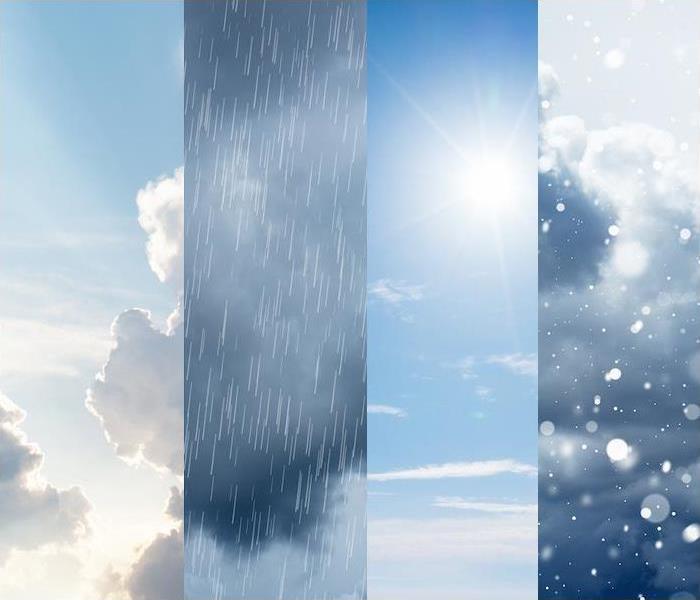 SERVPRO of Shippensburg/Perry County is a click away if you experience any damage.
SERVPRO of Shippensburg/Perry County is a click away if you experience any damage.
As one of the world’s biggest nations, the United States features a highly diverse climate across the board. As a consequence, seasonal weather in the United States is not one-size-fits-all—different parts of the country experience unique weather patterns, resulting in varying degrees of weather threats for different areas.
Let’s take a look at the weather patterns that may develop as spring approaches and warm and cold air masses mix throughout the country—as well as what we might expect here in Pennsylvania.
The Pacific Northwest’s spring months are prone to severe rain, which may cause floods and water damage. Snow will continue to build at higher altitudes, and the resulting melting and runoff may cause issues of its own.
The Upper Midwest and Northeast, including Pennsylvania, enjoy the longest winters and will have cold temperatures throughout the season. The Great Lakes’ lake effect snow poses a considerable challenge to our state’s northern area, which may get more than 100 inches of snow each year. From Maine to the Dakotas, folks can anticipate frigid weather, blizzards and heavy snow even until late spring or early summer.
The Southwest and southern West Coast, on the other hand, will need to be on the lookout for severe heat waves that may harm people and property. The South Pacific area, including Hawaii, will be on high alert for the risk of tectonic activity-caused tsunamis.
Windstorms, derechos and the possibility of wildfires, which can spread quickly when winds are strong and conditions are dry, will also be on the radar for the central United States, from Iowa to Texas. Tornado Alley, which is particularly prone to tornadoes, is a prominent component of this area.
Finally, we should anticipate a broad variety of severe weather occurrences in the Southeast, from thunderstorms and tornadoes in landlocked regions to early-season hurricanes along the coast later in the spring.
Extreme weather is a risk wherever you reside in the United States. While conditions differ by state, it never hurts to be aware of and prepared for extreme weather.
If extreme weather leaves you with damage from water, fire or other elements, help is a click away. Contact SERVPRO for fast, expert recovery.
Don’t Get Surprised by Winter Storms and Weather | SERVPRO® of Shippensburg/Perry County
11/22/2021 (Permalink)
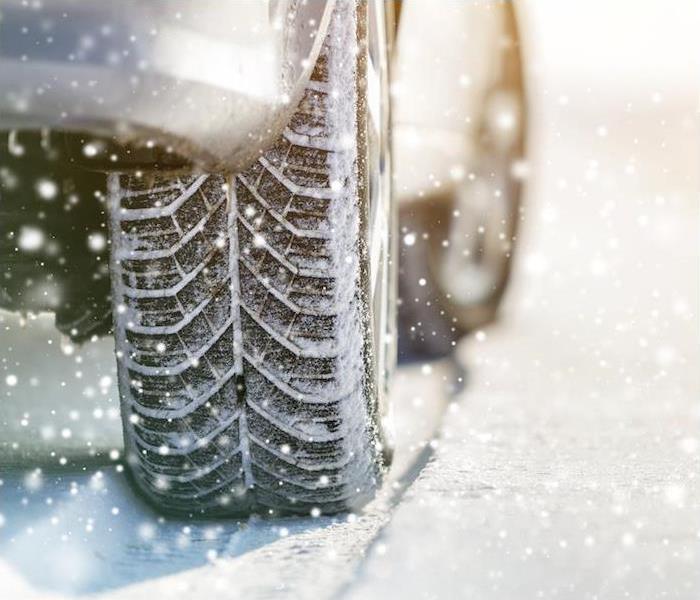 If winter weather should bring damage to your home or business, contact SERVPRO of Shippensburg/Perry County for fast, restorative solutions.
If winter weather should bring damage to your home or business, contact SERVPRO of Shippensburg/Perry County for fast, restorative solutions.
Take it from that “thrones” guy—winter is most certainly coming. (How did he know?)
Whether you look forward to winter all year or you tolerate it as a mere bridge to spring, you can’t stop the sting of winter weather from reaching Lebanon County once again. So before your social calendar is full to the brim with family gatherings, holiday events or end-of-year parties, let’s take a look at a few things you’ll want to take care of before the reality of winter sets in.
Protect Your Family
If a winter storm suddenly overtakes the area, you’re going to be glad you have an emergency action plan. This will help your family know how and when to act, where to meet and how to stay in contact. Prepare and rehearse to protect your family.
Get your car ready, too—make sure your tires are in good shape, your anti-freeze and fluids are full, and conduct any needed maintenance so you don’t find yourself stuck out in the cold.
Stock both your car and home with emergency kits, which can keep you safe, fed and warm in a crisis.
Protect Your Home
Frozen pipes are an unfortunate reality for homeowners in winter, but they can be largely avoided by taking the proper precautions, be it insulating pipes or letting faucets drip.
It’s time to check up on your home heat system as well. If you have an electric or gas HVAC system, let a pro give it a once-over and perform any needed maintenance, to ensure that your system is primed to combat the winter chill.
If you burn wood, keep an extra supply on hand in case extreme weather keeps you stuck at the house for a while. Clean your fireplace or furnace to ensure safe use and a healthy breathing environment.
Protect Your Pets
Most pets are simply not equipped for Pennsylvania winters. Bring pets indoors during the cold months, and make a comfortable place for them to stay.
If you own any livestock or equine animals, make sure they have updated, adequate shelter and constant access to water that isn’t frozen.
Watch for Melts and Flooding
After long winters and periods of snow and ice, floods and ice dams can cause trouble in affected areas. From local waterways being overrun with runoff to ice and snow melting through cracks in your roofing, these can cause serious damage and danger.
If winter weather should bring damage or flooding to your home or business, contact SERVPRO for fast, restorative solutions.
Don’t Get Surprised by Summer Storms | SERVPRO® of Shippensburg/Perry County
8/17/2021 (Permalink)
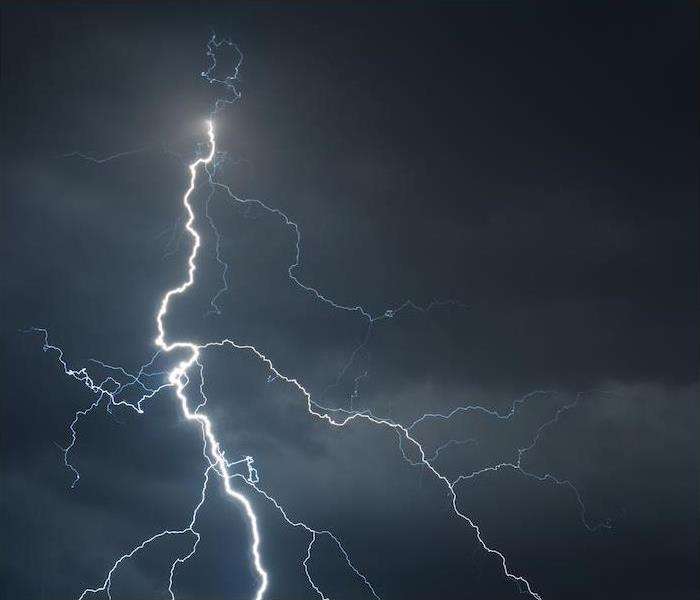 If storms cause damage to your home or business, SERVPRO of Shippensburg/Perry County is on the line, ready to make things right.
If storms cause damage to your home or business, SERVPRO of Shippensburg/Perry County is on the line, ready to make things right.
It’s summertime in Pennsylvania, and that means most people can’t wait to get out and do something. The weather is warm, and the sun is out—what’s not to enjoy?
Maybe you’re heading to Philly to cheer on the home team, or planning a weekend indulging in Hershey. But wherever you go, don’t leave your umbrella at home.
Despite the heat and sunshine (or rather, because of it), summer weather is more likely to produce thunderstorms. Rainfall in Lebanon County peaks in summer, as moisture in the atmosphere combines with the warm summer air to create storm conditions.
Be Storm-Alert
Storms should never be discounted as child’s play. If warnings are issued, pay attention and go over the game plan. An NOAA Weather radio can be a constant help as well, providing frequent updates and giving you a source of information even if you lose power.
If the forecaster warns of potential flooding, take it seriously. You may need to rearrange travel plans or cancel events. And check the area around your house—you may need to move or tie down garbage cans, trampolines or other items that could be washed or blown away.
Storm prep isn’t as fun as watching Bryce Harper hit homers, but it’s crucial if you want to stay safe. Storms and resulting flooding claim a number of lives each year, and some simple preparation and caution could prevent a majority of those fatalities.
Be Storm-Safe
Hunker down indoors during a storm, and stay inside until thunder has stopped for at least 30 minutes—this indicates that you’re out of range for a lightning strike, which can still occur up to 10 miles from an active storm.
Windows can shatter in a storm, so don’t sit or stand near them during the storm. And tubs, showers and the water they contain can conduct electrical current, so wait until later to take that bath.
Make sure you’ve got an emergency kit in the house or shelter, and keep a ready kit in the car as well, in case things turn ugly and you need to evacuate.
Floodwater is a danger for a bevy of reasons. It’s incredibly strong (like, carry-your-SUV-away strong), it can wash away concrete roads and the ground under them, and touching it can cause health effects.
There are any number of dangers that can come into play in a thunderstorm, and it’s always best to be cautious and put things on hold until storms safely pass. If storms cause damage to your home or business, SERVPRO is on the line, ready to make things right again.
Shippensburg and Perry County Residents Can Trust Us With Disaster Cleanup | SERVPRO® of Shippensburg/Perry County
8/10/2021 (Permalink)
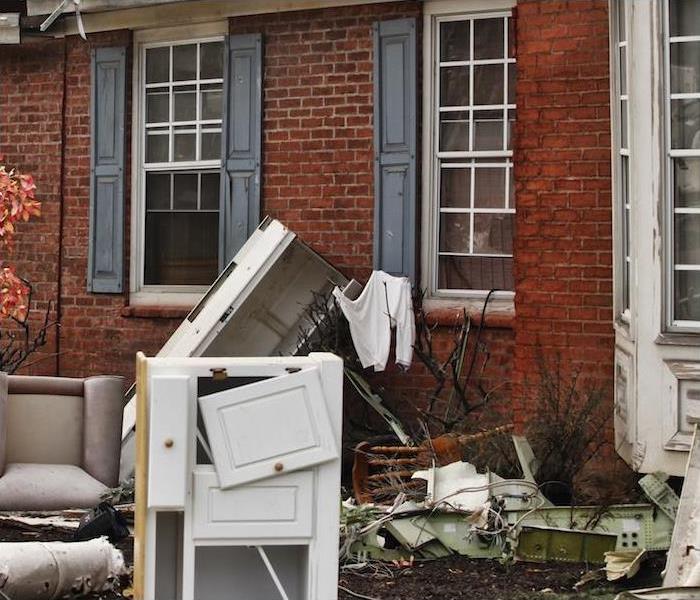 When you are dealing with any damage, immediate action is crucial. SERVPRO of Shippensburg/Perry County is your local restoration expert.
When you are dealing with any damage, immediate action is crucial. SERVPRO of Shippensburg/Perry County is your local restoration expert.
You’re used to playing a lot of roles as a homeowner of business owner. You’re an accountant and a chef. A CEO and a parent. A planner and an IT technician. You’re handling it all really well, and for that you deserve an award.
But regardless of the roles you’re playing, we’d be willing to bet you haven’t prepared to suddenly become a disaster recovery expert.
When natural disasters, accidental fires or water damage create an emergency that requires immediate restitution, you can’t handle it all—you need prompt, dependable help from someone you can trust.
Here’s why you should trust SERVPRO to see you through.
We’re Always Ready and Faster to Any Size Disaster
Like a superhero responding to their signal in the night sky, we’re sitting on go at all times, ready to act at a moment’s notice. With a crack team of experts on standby 24 hours a day, we’ll be on the way before you can say, “Gotham needs me.”
Every moment matters in a crisis, and the case of disasters it means more mold growth, stronger smell of smoke or dank carpet. A rapid response makes all the difference, and having a local SERVPRO franchise situated right here in Shippensburg/Perry County means you get the multiplied strength of a limber, knowledgeable neighborhood team with the backing of a resource-rich national network.
We’re Trained to Handle Residential and Commercial Services
Different solutions are necessary for different situations, and that means customized service for businesses and homes—we’re over a half century deep into being an industry leader, so we’ve got the knowledge base to be able to manage your situation, no matter the setting or cause.
We’ll Make It "Like it never even happened."
Brilliant work, immaculately executed—that’s what you can expect when we take up your cause. Our cleanup and recovery methods are extensive and thorough, and our footprint is so minimal that you’ll have to remind yourself that we were ever there.
We Offer the Services You Need in a Changing World
Disease prevention is a major concern for businesses, and we provide them ultra-grade cleaning assistance that far outshines standard sanitation services.
Your business will have never been cleaner, and your returning customers will feel it right away.
Regardless of why you need cleanup or disaster recovery, SERVPRO has the tools, the technicians and the training to get your situation under control. When you’re ready to get help from the best, get in touch with SERVPRO.
The Cost and Frequency of Extreme Weather in 2020 | SERVPRO® of Shippensburg/Perry County
7/8/2021 (Permalink)
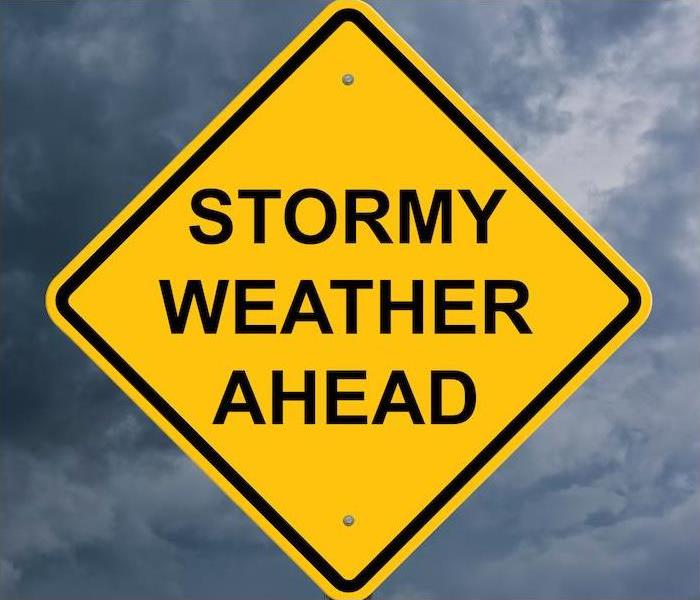 When storms do damage, we go to work to make things right. Contact SERVPRO of Shippensburg/Perry County to start the restoration process.
When storms do damage, we go to work to make things right. Contact SERVPRO of Shippensburg/Perry County to start the restoration process.
Most of us are all too aware that 2020 was a devastating year. But the degree to which 2020 was disastrous might go even further than you realize—not only did the year see a global pandemic and a nationwide quarantine, it also broke existing records for extreme weather disasters.
In fact, 2020 saw more weather disasters than any previous year on record.
The National Weather Service classifies a weather event as a disaster once it causes at least a billion dollars in damages, and 2020 brought a record 22 of these events. That doesn’t even count the numerous storms that only caused a few hundred million in destruction—there were so many storms in the Atlantic last year that the NWS had to use letters from the Greek alphabet to give them all names because it ran completely through its planned list of names for the year.
And even here in Pennsylvania, we had more weather alerts in 2020 than “tornado alley” states like Kansas.
Not Just Hurricanes
The blame often falls on hurricanes first when we think of extreme weather damage, but in truth, the most expensive disasters of 2020 in the contiguous United States were thunderstorm systems and the tornadoes some of them birthed: Fourteen of the 22 major events were storm-related.
Not Just 2020
While we certainly would hope 2020 to be an extreme example, it does seem to be following a trend of especially dangerous years for severe weather outbreaks. The previous two years joined caused a combined $136 billion in damages, and 2017 saw a record-high $300 billion.
Indeed, each of the last 10 years has suffered at least eight major weather disasters in the U.S., and the last six years have seen a minimum of 10 each.
Storms happen year-round and are no respecters of locale, so it’s crucial that we stay alert and prepared when storms are forecast. But if extreme weather overcomes your preparations, remember that SERVPRO is on call 24⁄7 to help you through the restoration and recovery process.
When storms do damage, we go to work to make things right. Contact SERVPRO today to see how we can help.�
How Thunderstorms Impact Pennsylvania | SERVPRO® of Shippensburg/Perry County
7/2/2021 (Permalink)
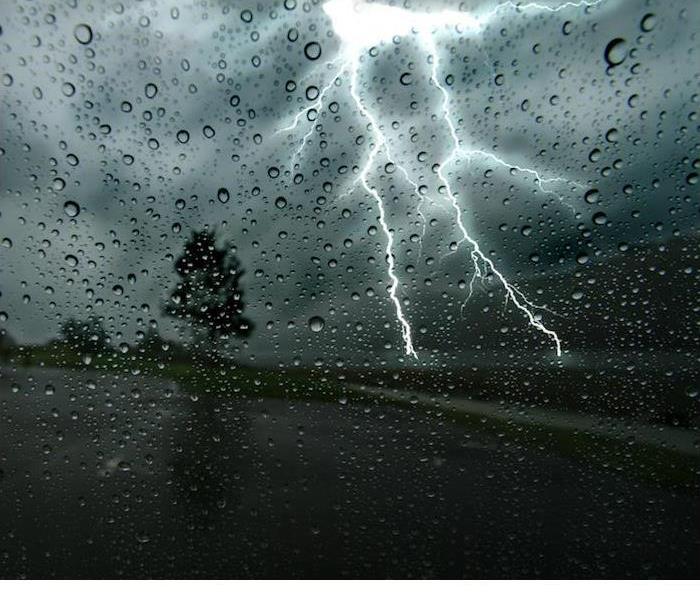 Storms can be beautiful, but can also cause damage
Storms can be beautiful, but can also cause damage
Just over a week ago, the Pennsylvania Emergency Management Agency sponsored a week dedicated to educating the public and bringing awareness to the severe weather patterns that impact our communities. The information discussed the ins and outs of thunderstorms, hail and flooding, and we wanted to help continue that conversation by looking at some of the ways that storms impact Pennsylvania.
Spring and summer are the most common times for thunderstorms. Thunderstorms are defined as any storm that has thunder and lightning.
A severe thunderstorm is classified as a strong storm that has thunder and lightning and contains hail that is one inch or larger in diameter and has straight-line winds of 58 miles per hour or greater.
The Main Differences That Mean a Storm Is Called “Severe”
Lightning strikes. Lightning is considered one of the most dangerous elements of a thunderstorm for various reasons, but its elusiveness has evaded scientists as they are not able to identify where or when the next strike will be. Not only does it have the ability to cause serious damage to property, such as starting a house fire or felling trees, it has also been reported that about 300 injuries each year are due to lightning strikes.
Hail damage. Hail that comes in a severe thunderstorm is at least one inch or larger in diameter, many times much larger than this. Couple this size with the speed at which it falls (up to 72 miles per hour), and it is a recipe for significant damage, especially to uncovered vehicles, people or pets that are not adequately protected, and the sidings and roofs of houses.
Flash flooding. It is a common misconception that flooding can only happen in designated flood plains. Flash flooding is possible at any time and under the right conditions, it can create a life-threatening scenario in mere minutes. If there is heavy rainfall, a backed-up storm drain or overflowing roadside ditches, these flooded roadways can do damage to vehicles and also have the potential to carry away a car in the tide.
Thunderstorms can be a serious problem for business- and home-owners. If you have been impacted by a storm, we are here to help. Contact SERVPRO of Shippensburg/Perry County to see how our team and techniques can get your property back to pre-storm condition.
Hurricane Irma
11/27/2017 (Permalink)
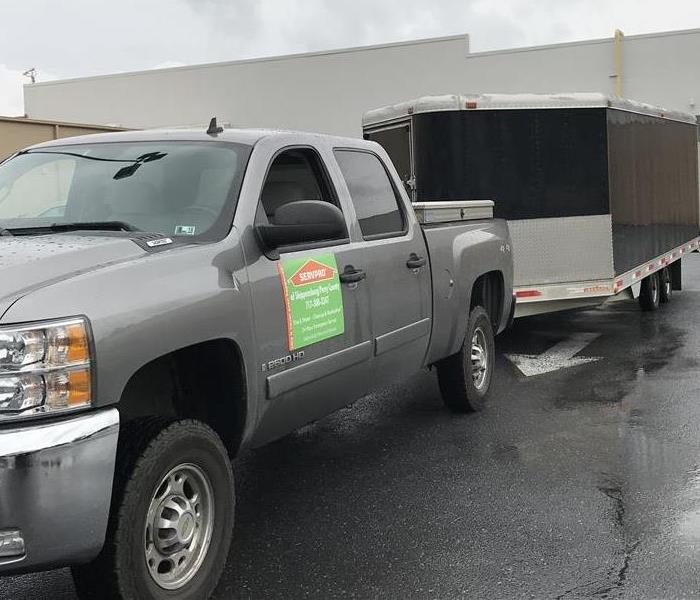 As our technicians loaded and ready to pull out.
As our technicians loaded and ready to pull out.
After Hurricane Irma hit Texas, we set out with our local SERVPRO storm team to assist those affected by the terrible storm. Our team set out September 7th and returned October 7th for a full month of helping those devastated. It was an experience we are glad we had, but do not wish that devastation on anyone. We did everything from removing items that were ruined or ripping apart walls and floors from the water damage done to just placing our dehumidifiers and air movers in to dry the houses out or just checking some places for moisture. Some only had a few inches of water enter their house leaving minimal damage, while others had 6-8 feet of water enter leaving everything damaged. Since it was storm water and entered from the outdoors after being in contact with anything and everything in its way, anything it touched was ruined because it was considered category 3 water, which is often referred to as sewage water. Even though everyone we dealt with, whether they were located in Sour Lake or Houston areas, were affected by this storm, and many lost numerous or all of their items, they were very grateful for our services and treated us as guests to their area.





 24/7 Emergency Service
24/7 Emergency Service



















